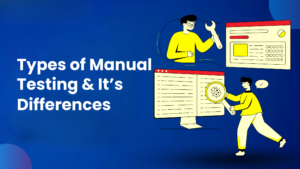

Manual vs. Automated Testing: When to Use Each Approach
Software testing is a crucial aspect of the software development lifecycle, ensuring the quality and reliability of software applications. Two primary approaches to testing, manual and automated testing, have emerged as valuable techniques. While both have their merits, understanding when to use each approach is vital for optimizing testing efforts and achieving efficient and effective results. In this blog post, we will explore the strengths and weaknesses of manual and automated testing and discuss scenarios where each approach shines.
Manual Testing:
Manual testing involves the use of human testers to execute test cases and validate the behavior of software applications. It relies on human observation, intuition, and interaction with the system. Here are some situations where manual testing is beneficial:
a) Exploratory Testing:
Exploratory testing is an approach that involves simultaneous learning, test design, and test execution. Manual testing excels in exploratory testing, as human testers can explore the application, identify unforeseen issues, and provide valuable feedback based on their experience and expertise.
.b) Usability Testing:
Manual testing is invaluable when it comes to evaluating the usability and user experience aspects of software applications. Testers can assess the software’s intuitiveness, navigation, and overall user-friendliness, providing subjective insights that automated tests may not capture effectively.
.c) Ad-hoc Testing:
Ad-hoc testing refers to testing without a predefined test plan. It is often performed when time is limited, or when unexpected issues arise. Manual testing is well-suited for ad-hoc testing, as testers can quickly adapt and apply their problem-solving skills to identify and address immediate concerns.
d) User Interface Testing:
Manual testing allows testers to thoroughly evaluate the user interface (UI) of an application, ensuring that it is visually appealing, consistent, and functions correctly across different devices and screen sizes. Testers can identify UI bugs, design inconsistencies, and accessibility issues that may impact the user experience.
Automated Testing:
Automated testing involves the use of software tools and scripts to execute test cases and verify the behavior of applications. Here are scenarios where automated testing provides significant advantages:
a) Regression Testing:
Regression testing involves retesting software functionalities after making changes to ensure that existing features have not been negatively affected. Automated testing excels in regression testing, as it can quickly execute a large number of repetitive test cases, freeing up human testers for more complex tasks.
b) Performance Testing:
Performance testing focuses on evaluating the responsiveness, scalability, and stability of software applications under various load conditions. Automated testing tools can simulate multiple virtual users and generate heavy loads, allowing for efficient performance testing and accurate measurement of system behavior.
c) Data-Driven Testing:
Data-driven testing involves executing test cases with different input data sets. Automated testing is well-suited for this scenario, as it can automate the execution of test cases with multiple data variations, significantly reducing the time and effort required compared to manual testing.
d) Large-Scale Testing:
When testing large-scale systems with complex architectures and numerous integrations, automated testing can be a game-changer. It enables testers to execute extensive test suites, validate end-to-end flows, and detect issues that may arise due to system interactions and dependencies.
Hybrid Approach :
In many real-world scenarios, a hybrid approach that combines both manual and automated testing can be the most effective. Leveraging the strengths of each approach, organizations can optimize their testing efforts. For example:
a) Test Planning and Design:
Manual testing can be used in the initial phases of test planning and design. Testers can brainstorm test scenarios, identify critical functionalities, and create test cases based on their domain knowledge and expertise.
b) Test Execution and Reporting:
Automated testing can take the lead in executing repetitive test cases, allowing for faster feedback cycles and freeing up testers to focus on more exploratory and complex testing tasks. Additionally, automated test scripts can generate detailed test reports, providing objective metrics and facilitating defect tracking.
c) Test Maintenance:
Automated tests require regular maintenance due to changes in the application or test environment. However, manual testing can play a vital role in validating and updating automated test scripts, ensuring their accuracy and reliability.
Conclusion
The choice between manual and automated testing depends on various factors, including the nature of the project, time constraints, budget, and the specific testing objectives. Manual testing is best suited for exploratory testing, usability testing, ad-hoc testing, and evaluating the user interface. Automated testing shines in regression testing, performance testing, data-driven testing, and large-scale testing. However, a hybrid approach that combines both methodologies can provide the best of both worlds, optimizing testing efforts and delivering high-quality software solutions. Ultimately, the key lies in understanding the strengths and weaknesses of each approach and selecting the most appropriate strategy for the given context.
Consult Us


















